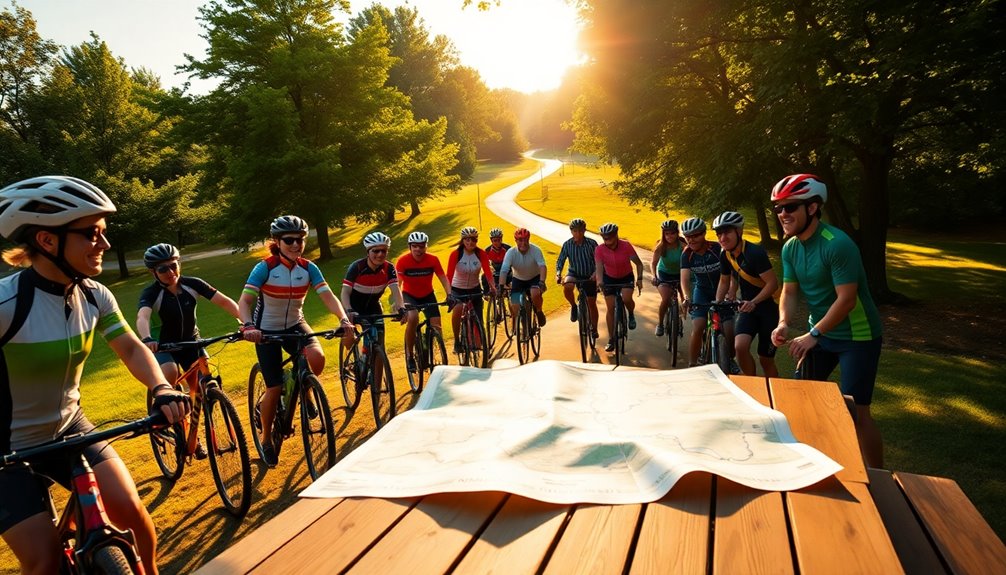Organizing and participating in community group rides is an exciting way to engage with fellow cyclists. Start by planning a safe, enjoyable route and promoting it through social media and local bike shops. Make sure to prepare for the day with volunteers to manage registration and safety. During the ride, keep the group together and foster camaraderie. Afterward, share experiences and gather feedback to improve future events. There's so much more to discover about creating memorable rides ahead.
Key Takeaways
- Plan a safe and enjoyable route, incorporating rest stops and bike-friendly destinations to enhance the riding experience.
- Promote the ride through social media, local bike shops, and word-of-mouth to attract participants effectively.
- Use a registration platform to collect participant information, waivers, and fees while ensuring a smooth check-in process.
- Maintain a cohesive group during the ride by using clear communication and hand signals for safety.
- Foster community by engaging in post-ride activities and encouraging feedback, photos, and stories from participants.
Planning the Ride

When you start planning the ride, it's essential to choose a date and time that allows for a 15-30 minute meet-up before departure, ensuring everyone is ready to go.
Next, design and test the ride route in advance. Check for roadwork or obstacles that could disrupt the journey, so you guarantee a smooth experience for your local group.
Incorporate a bike-friendly food destination within the route or at the end; it'll provide a rewarding break for participants.
Highlight lesser-known landmarks or monuments along the ride to enhance the experience and encourage exploration.
Finally, create and share a custom map using Google My Maps. This way, everyone can easily access the ride route and feel confident about organizing a group ride.
Promoting the Ride
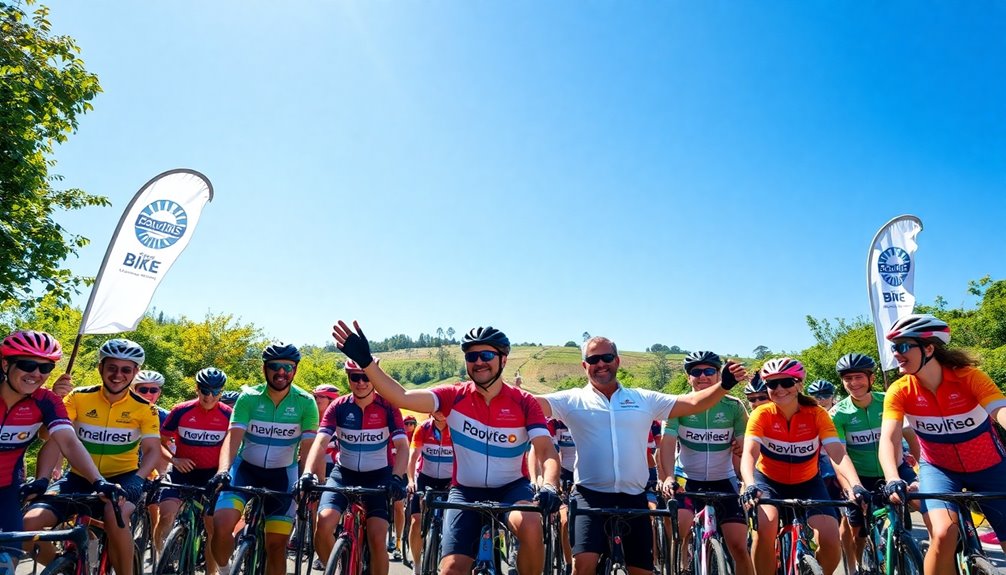
Here's how you can generate excitement for your upcoming group ride: Start by promoting the ride in engaging ways that catch people's attention. Here's how:
- Create a Facebook event: Include all essential details like the ride summary, date, time, and contact information. This maximizes visibility and encourages sharing.
- Design flyers: Distribute them at local bike shops, especially those serving as start or finish points. This targets potential riders directly.
- Leverage social media: Share updates and information in local cycling forums and groups to reach a broader audience.
Encourage word-of-mouth promotion by inviting coworkers and friends to join. The more people know about the ride, the more excitement you'll create! Additionally, consider outlining types of bicycle races to inspire participation and connect riders with similar interests.
Final Preparations
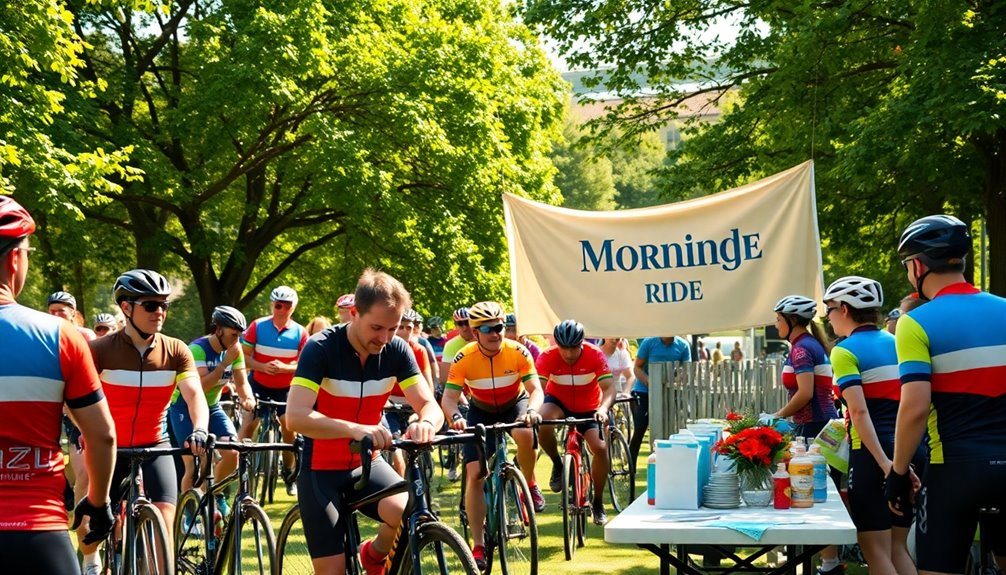
Final preparations are essential for guaranteeing a successful group ride. One day before, review the ride route for new obstacles to confirm a smooth experience. On ride day, arrive early to greet participants and share last-minute details on ride etiquette. Consider recruiting a volunteer as a sweep rider to keep everyone together.
| Task | Purpose | Timing |
|---|---|---|
| Review route | Identify obstacles | One day prior |
| Arrive early | Welcome participants | Ride day |
| Brief ride etiquette | Guarantee safety and enjoyment | At ride start |
Introduce yourself and thank participants to foster a positive atmosphere. These final preparations will enhance your local rides and promote a community spirit.
During the Ride

During the ride, safety should always be your top priority.
You'll want to keep the group cohesive by maintaining a steady pace and using clear communication signals for turns or hazards.
Staying flexible and ready to adjust the route or speed will help everyone enjoy the ride together.
Safety First
While riding in a community group, staying aware of your surroundings is essential for everyone's safety. To guarantee safety first, keep these points in mind:
- Use hand signals and audible cues to alert others about turns and road hazards. This helps maintain smooth navigation and prevents surprises.
- Regularly check for vehicles, pedestrians, and obstacles. Staying vigilant can prevent accidents and keep everyone safe.
- Follow traffic laws and maintain a steady pace. Abrupt speed changes can lead to collisions, so communicate openly about comfort levels and adjust as needed.
Group Cohesion
Riding in a community group isn't just about safety; it's also about fostering a strong sense of unity among participants.
To enhance group cohesion, establish a steady pace that accommodates the slowest rider, usually around 12 mph for casual rides. Incorporate regroup spots at predetermined intervals to guarantee no one gets left behind.
Avoid abrupt braking and maintain smooth shifts in speed to keep the flow consistent. Regularly check in with group members, especially during climbs, to foster camaraderie and support.
Use hand signals and audible cues to keep everyone aware of turns and hazards. By practicing these ride skills, you'll help maintain your position within the group, assuring a safe and enjoyable experience for all. Additionally, be mindful of emotional stress that could affect individual riders, as it can impact their performance and enjoyment during the ride.
Communication Signals
Effective communication signals are essential for ensuring everyone's safety and awareness on group rides.
When participating in local cycling, using clear signals can help prevent accidents and keep the group cohesive during a no-drop ride. Here are three key communication signals to remember:
- Hand Signals: Use gestures to indicate turns or point out obstacles. A raised hand can signal mechanical issues.
- Verbal Cues: Shout out warnings like "Car up!" or "Hole!" to alert fellow riders of potential hazards.
- Regular Check-ins: Maintain communication by checking in with group members, ensuring no one falls behind or faces issues alone.
Post-Ride Considerations
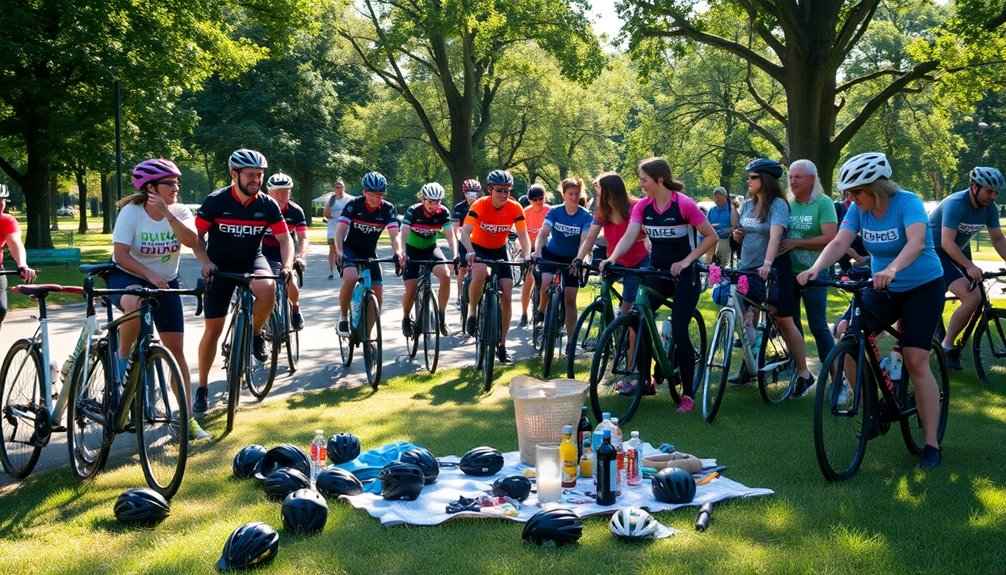
As the ride concludes, it's important to celebrate the achievement and foster a sense of community among participants. Engaging in post-ride social activities, like group meals or gatherings, strengthens relationships and enhances the overall experience.
Encourage everyone to share their post-ride photos and stories on social media; this not only keeps the excitement alive but also promotes camaraderie within the cycling community. Gathering feedback from riders through surveys or comment cards is essential, as it provides valuable insights for improving future events.
Initial Planning and Registration
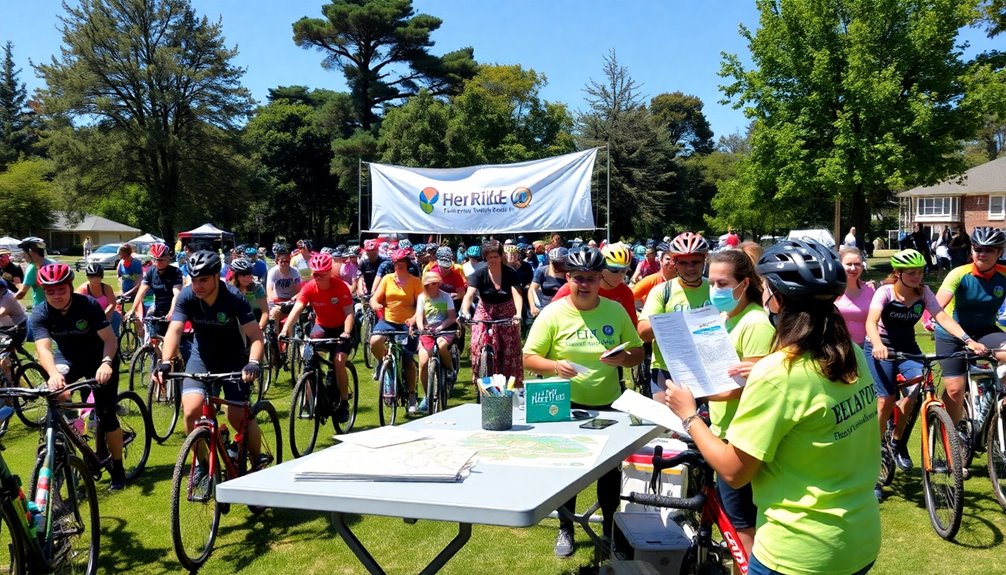
To kick off your community ride, start by assembling a reliable core crew that can share the workload and skills needed for smooth planning.
Next, secure any necessary permits and insurance early on to guarantee you're covered legally.
Finally, set up an efficient registration process that includes liability waivers to streamline check-in and protect everyone involved.
Core Crew Formation
Forming a core crew of dependable individuals is essential for organizing successful community group rides, especially when you want to distribute the workload and tap into various skills.
Start by assembling a team that shares your passion for cycling and community engagement. Here are three key steps to take into account:
- Select Roles: Identify members with strengths in areas like logistics, marketing, and rider safety to cover all bases.
- Engage Local Businesses: Connect with nearby shops for sponsorships, which can provide resources and enhance the ride's appeal.
- Plan Ahead: Choosing a date early helps avoid conflicts, allowing your core crew to focus on details like upcoming turns and participant registration.
With the right core crew, your ride will be set up for success!
Permit and Insurance
Securing the necessary permits and insurance early in your planning process is essential for a smooth community ride. It not only complies with local regulations but also protects you from potential liabilities. Consult an attorney to draft waivers that mitigate liability risks, as waivers alone may not fully shield you from negligence claims. Consider obtaining liability insurance to cover possible lawsuits. Organizations like the League of American Bicyclists offer tailored options for cycling events. Charging minimal dues for membership can help offset costs associated with permits and insurance.
| Type of Coverage | Cost Estimate | Benefits |
|---|---|---|
| Liability Insurance | $200-$500 | Protection against lawsuits |
| Event Permit | $50-$300 | Legal compliance |
| Participant Waiver | $100 | Risk mitigation |
| Total Estimated Cost | $350-$900 | Peace of mind for organizers |
Efficient Registration Process
As you immerse yourself in planning your community ride, establishing a clear and user-friendly registration platform is essential for a smooth experience.
To guarantee efficiency, consider these key elements:
- Essential Information: Include ride details, participant limits, and fees upfront to eliminate confusion.
- Liability Waivers: Require participants to sign liability waivers and photo releases during registration for protection and consent.
- Volunteer Assistance: Create a core crew of volunteers to help manage registration flow and provide information on event day.
Utilizing online tools or apps for registration not only simplifies tracking of participants but also aids in communication leading up to the ride.
A streamlined process will enhance participant satisfaction and make your event successful.
Mapping the Ride and Volunteer Coordination
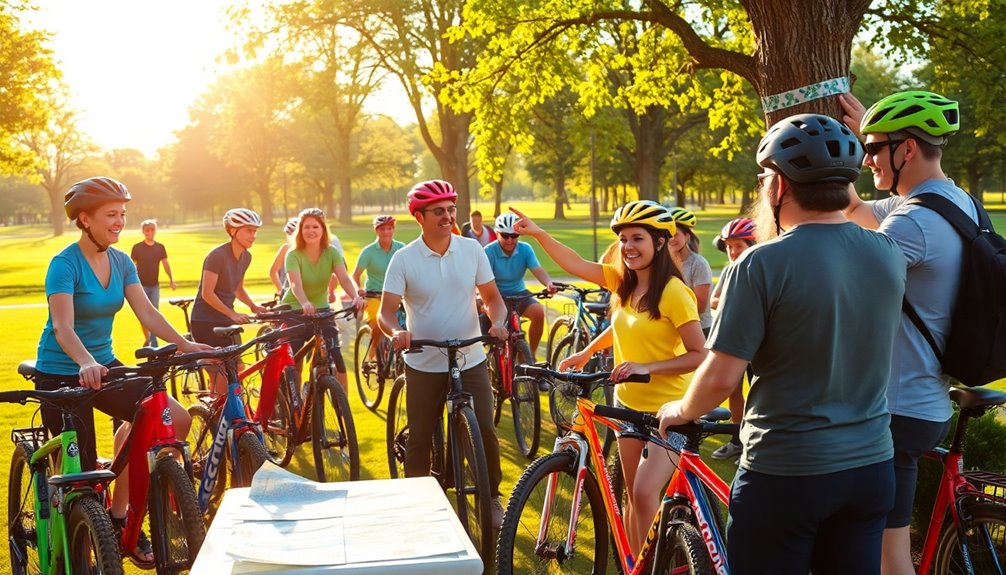
When planning a community group ride, it's vital to map out the route thoughtfully to guarantee both safety and enjoyment for all participants.
Utilize GPS cycling apps like Strava or Cyclemeter for accurate mapping the ride, ensuring scenic and safe paths. Choose convenient start and finish locations, keeping accessibility and parking in mind.
Utilize GPS cycling apps like Strava or Cyclemeter to map a scenic and safe ride, considering accessible start and finish locations.
Proper volunteer coordination is important; assign specific roles like road captains and first aid station attendants. This way, you're ensuring everyone knows their responsibilities.
Plan multiple pit stops for riders to regroup, rest, and hydrate, maintaining group energy levels.
Finally, share the ride route on social media beforehand to gather feedback and make adjustments, enhancing the overall experience for everyone involved.
Fundraising, Donations, and Participant Considerations
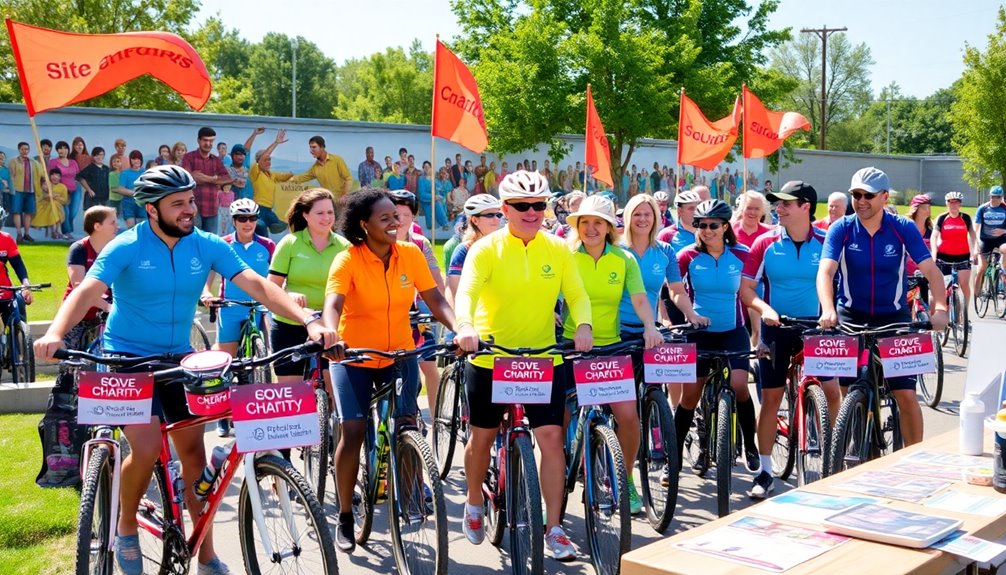
After finalizing the route and coordinating volunteers for your community group ride, the next step is to focus on fundraising and donations.
Setting clear targets early on is essential since raising funds often supports local charities. Here are some strategies you can implement:
- Engage local businesses: Create sponsorship packages outlining benefits to attract donations and support.
- Organize raffles or auctions: These activities can generate excitement and additional funds, encouraging participant contributions.
- Prioritize inclusivity: Guarantee accommodations for riders with physical challenges, fostering a sense of belonging and broadening participation.
Additionally, consider exploring partnerships with local industries, such as the utilities sector, which may provide funding opportunities and resources for community initiatives.
Clear communication about your event's goals, donation options, and participant benefits will enhance engagement and cultivate a supportive community culture.
Environmental Practices and Post-Event Activities
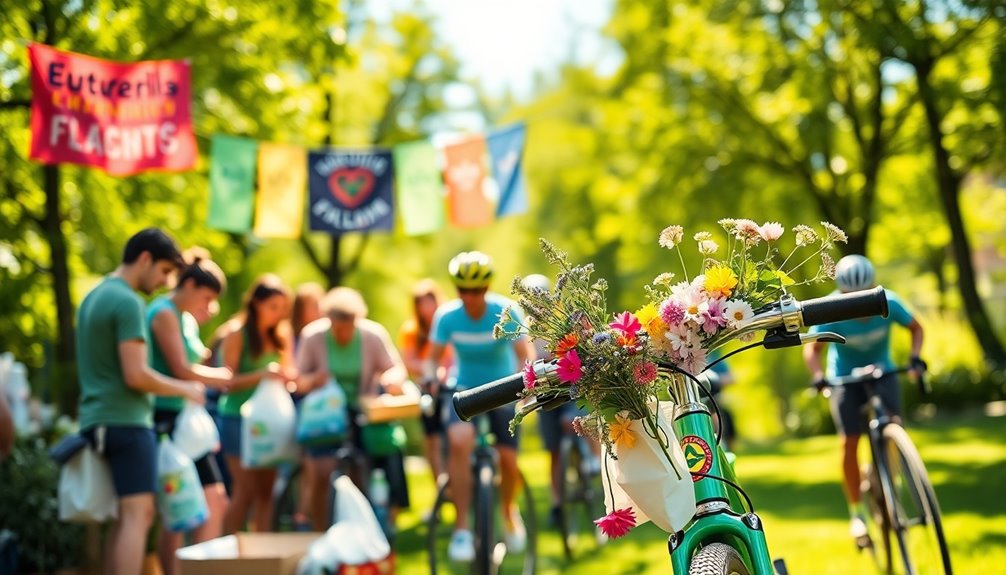
To create a lasting impact on the environment, integrating sustainable practices during your community group ride is essential. Emphasizing environmental responsibility not only enhances your event's reputation but also reduces ecological impacts.
Plan for proper waste disposal by providing clearly marked recycling bins, and engage participants in recycling efforts. Educate them on waste reduction to foster a culture of environmental awareness within your cycling community.
Plan for effective waste disposal with clear recycling bins and engage participants in fostering environmental awareness.
After the ride, collect feedback on participants' experiences regarding these practices. This will help you identify areas for improvement and future sustainability initiatives.
Maintaining relationships with participants and sponsors post-event encourages ongoing discussions about eco-friendly practices, ensuring your community continues to prioritize environmental responsibility in future rides.
Wrapping Up the Ride

As you finish your community group ride, celebrating the accomplishment together is essential for building camaraderie among participants.
Consider organizing a small gathering or post-ride meal to enhance this sense of community. Here are three ways to wrap up effectively:
- Share Highlights: Recap the ride, emphasizing distance covered and memorable moments, reinforcing participants' achievements.
- Gather Feedback: Use informal discussions or surveys to collect valuable insights, helping you improve future events and participant experiences.
- Acknowledge Contributions: Thank volunteers and sponsors publicly, fostering goodwill and support for upcoming rides. Additionally, consider incorporating essential oils for relaxation after the ride to enhance the overall experience for participants.
Frequently Asked Questions
How to Organize a Community Bike Ride?
To organize a community bike ride, start by choosing a catchy name and creating an event on social media to share details like the date, time, and route.
Design a scenic path that's safe and bike-friendly, including breaks for snacks and sights.
Reach out to local bike shops for support and promote the ride through flyers and online platforms.
Finally, gather feedback after the event to enhance future rides and strengthen community bonds.
What Are the Benefits of Group Rides?
Group rides offer numerous benefits.
You'll enhance your cycling skills by learning from experienced riders, picking up techniques like drafting and safe riding practices.
Riding with others boosts your motivation and pushes your limits, helping improve your physical fitness.
Plus, you'll explore new routes and discover areas you mightn't ride alone.
The camaraderie fosters a supportive environment, making cycling more enjoyable while also increasing safety through collective visibility on the road.
What Is Community Ride?
A community ride's like a flowing river, connecting cyclists of every skill level.
It's a joyful gathering where you pedal alongside others, sharing laughter and stories. These rides can range from leisurely spins to more intense challenges, all while exploring your local landscape.
You'll discover new paths, improve your cycling skills, and even make friends along the way.
It's not just about the ride; it's about the community you build together.
What Is the Cycling Group Rule?
The cycling group rule focuses on safety and etiquette to guarantee everyone enjoys the ride.
You need to follow traffic laws, signal your turns, and communicate openly about pace and route changes. Avoid abrupt braking and sudden movements to keep the group cohesive and safe.
Share the workload at the front without increasing the pace, and respect everyone's abilities to create a welcoming environment that encourages participation and enjoyment.
Conclusion
As you wrap up your community group ride, remember that "many hands make light work." Celebrate the connections you've fostered and the miles you've shared. Reflect on the joy and camaraderie that brought everyone together, and consider how this experience can inspire future rides. Take a moment to thank volunteers and participants for their efforts, ensuring everyone feels valued. With each ride, you're not just cycling; you're building a vibrant, connected community that thrives on shared passion.
